Turkey tail is a forager’s dream.
It’s an incredibly beneficial mushroom that grows practically everywhere, and it’s one of the easiest fungi to identify and harvest.
Known in the scientific community as Trametes versicolor, turkey tail has been used for immune support in Chinese medicine since 200 BCE. It is still used widely throughout the Eastern world today and is becoming more popular in Western countries as well.
Want to try it out for yourself?
The first step is learning how to recognize it. I’m here to help with a complete guide to turkey tail identification, including how to distinguish it from similar species and where to search for the best results.
How to Identify Turkey Tail
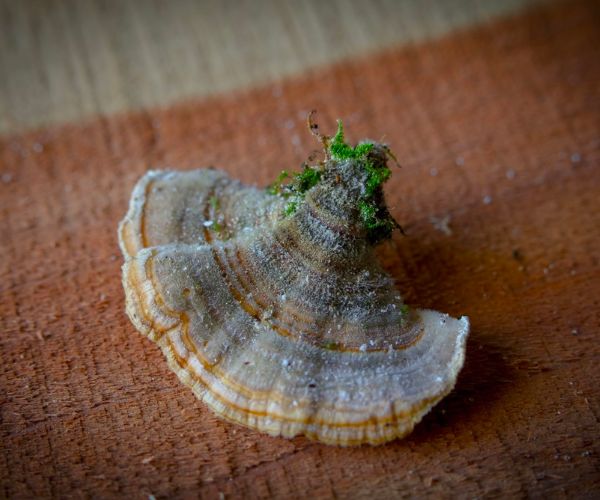
Turkey tail is named for its dashing good looks.
It’s a multi-hued mycelium strongly resembling an actual turkey’s tail, with a fan-shaped fruiting body measuring anywhere from 0.5” to 4” in diameter. The cap is sectioned into bands, each featuring a different color zone. The colors vary depending on location and weather conditions, but different zones will always contrast sharply.
Turkey tail is a saprobe mushroom, a decomposer that feeds on decaying matter. You’ll only find it growing on dead or dying wood, never from the ground or a cow patty. You also won’t find it growing alone. Turkey tails always grow together in shelves or rosettes. They sprout directly from their substrate and do not have a stem.
Unfortunately, turkey tail has many look-alikes. I can’t tell you how many times I’ve shouted in glee upon discovering a massive cache, only to be disappointed when I realized it wasn’t true turkey tail.
The good news is you can avoid the emotional rollercoaster of false identification. Once you find a batch of what you believe may be turkey tail, harvest a single fungus for examination. Then, look closely to separate the tails from the fails.
Pore Surface
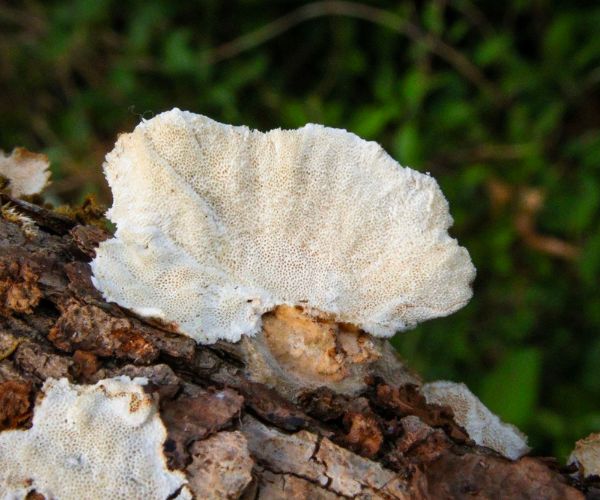
Does the fungus have a pore surface on its underside? If so, you’re on the right track. Like many saprobes, turkey tail is a polypore mushroom. Polypore shrooms reproduce by sending out spores through a series of tiny holes, or pores, on the underside of the cap.
Turkey tail pores are tiny and may be difficult to see. There should be between three and eight pores per millimeter of cap space. Turkey tail look-alikes may be smooth, toothed, or gilled. Some look-alikes also have pores, but these are much larger and spaced further apart. If each pore pops out to your naked eye, it’s probably not a turkey tail.
Texture
How does the fungus feel? Real turkey tail has a flexible and thin body. Unlike many other crust or bracket fungi, you can bend it easily. It usually has subtle ridges along its body and edges where it fans out, so the surface can feel bumpy. However, it will also feel soft to the touch.
The cap is covered with fine hairs that give it a nice, velvety finish. It reminds me of suede, and I find it quite pleasant to touch. Beneath the cap, the pore surface of a fresh turkey tail can feel slightly spongy. When it’s older, it may dry out and become more brittle.
Color
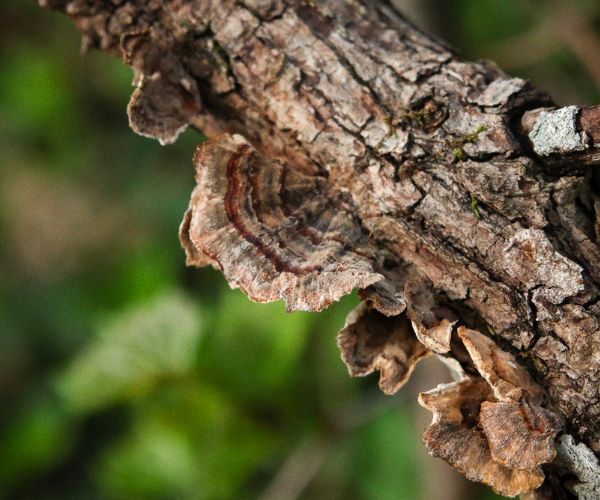
The pore surface of a turkey tail is white when the fungus is young and fresh. As it ages and dries, it can turn yellow and brown. The cap can be all sorts of different colors but commonly features gray, blue, red, brown, orange, and white hues. It will never be monochromatic.
Many saprobes have the same basic shape and size as turkey tail, even sporting similar bands. However, these imposters’ bands have different shades of the same color or only vary texturally. Genuine turkey tail has contrasting color zones.
The very last band on the outer rim of a fresh turkey tail cap is usually white, making it easier to identify from afar. As it ages, this whiteness may fade to cream or brown. Many look-alikes have an outer band that is brown, purple, or another color.
It’s important to note that you can’t go on color alone when identifying turkey tail. Some look-alikes have very similar coloring, so taking a holistic approach and examining each part of the shroom is vital.
Turkey tail checklist
- Growing on deadwood
- Rosettes or shelves
- No stem
- Fan shaped
- Contrasting color zones
- Thin and flexible
- Velvety cap
- Porous white/yellow underside
- Three to eight pores per millimeter
Turkey Tail Look-Alikes
There are hundreds of turkey tail look-alikes in the world. Fortunately, none are poisonous, and some are even beneficial. I included the following three species because they are common throughout North America and often get mistaken for the real deal.
Depending on where you live, you may get fooled by these fakers often. However, you might encounter different look-alike species entirely.
I encourage you to review the free field guide to turkey tail look-alikes by Michigan Tech’s August Camp and Tara Bal. That way, you can get familiar with other species that might trip you up as you forage.
Stereum Ostrea: False Turkey Tail Mushroom
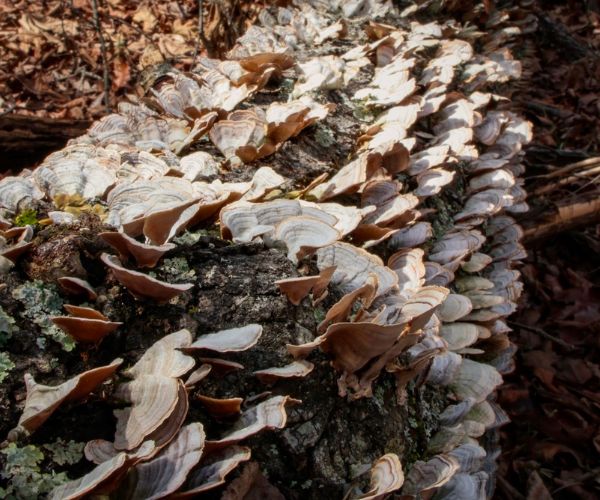
I find Stereum ostrea just as often as I find turkey tail—maybe even more. Also known as false turkey tail, these guys look exactly like Trametes versicolor when seen from above. They are bracket fungi that grow in the same conditions as turkey tail. You might even find them growing on the same tree!
False turkey tail is similar in size, shape, and texture. However, it is thinner and much more leathery than true turkey tail, becoming brittle and cracking as it dries. While its color zones may contrast sharply, you won’t find the same variety of colorful hues that turkey tail has. Stereum ostrea usually has more muted shades of white, gray, and brown.
The easiest way to tell false turkey tail apart from true turkey tail is to look at its underside. It will be smooth and brown instead of porous and white. False turkey tail and other members of the Stereum genus may look and act like bracket polypores but are actually crust fungi—so they won’t have any pores like a real turkey tail.
If you find it
Found some? Harvest it for soap or hand sanitizer. Early research indicates that Stereum ostrea has antimicrobial and antibacterial properties and may help guard against infections such as staph.
Trametes Hirsuta: Hairy Bracket Fungus
Trametes hirsuta is another look-alike that can fool beginners, especially from afar. Also known as hairy bracket fungus, this faker is a saprobe polypore, just like genuine turkey tail. It grows in the same conditions with a similar shape and size, banded with concentric rings on the cap and speckled with tiny pores on the bottom.
Upon close examination, Trametes hirsuta is easily distinguishable from turkey tail. It will have a much larger pore surface on the underside, with each pore clearly visible to the naked eye. True to its name, it can also be very hairy. However, this isn’t always the case.
The hairy bracket fungus can grow in clusters or rosettes but grows all by itself sometimes. It can also get much larger and thicker than turkey tail. Trametes hirsuta’s color bands are distinguished but more muted and consist primarily of grays, browns, and beiges.
If you find it
Found some? Harvest it for tea or tinctures. Some research indicates that Trametes hirsuta may enhance immune function similarly to turkey tail.
Trichaptum Biforme: Violet-Toothed Polypore
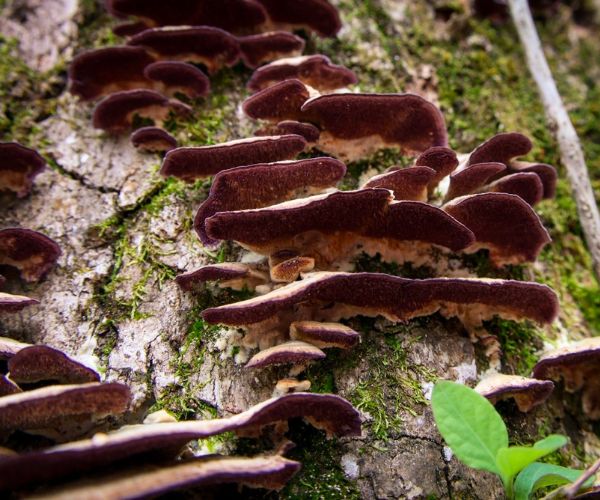
Trichaptum biforme is another saprobic polypore resembling turkey tail. It thrives in similar conditions and has similar coloring when viewed from above, but it has several distinct features that make it stand out.
When you look at a violet-toothed polypore, you’ll see how it got its name. Instead of a white underside speckled with delicate pores, Trichaptum biforme has elongated pores. The pores are thin and spindly, resembling nothing more than teeth. As the fungus matures, the pores can even look ragged.
The mushroom also has bright purple coloring. When it is very young, the entire fruiting body might be violet. The violet fades away as it grows, only appearing on the pore surface. When it nears the end of its life cycle, the violet color may fade entirely or only appear on the very edges of the fruiting body.
If you find it
Found some? Try making soap with it. Recent research indicates Trichaptum biforme could have strong antibacterial properties.


I may have some on my own property! Now I know what to look for. Thanks.